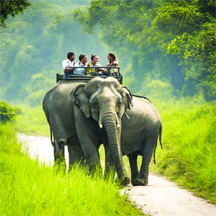Home to the largest population of the one-horned rhino on earth, Kaziranga National Park is one of India’s national treasures in terms of flora and fauna. Located in the state of Assam in North-Eastern India, its total area is shared by the districts of Nagaon, Golaghat and Karbi Anglong placing it roughly at the centre of the state. Approximately around five hours by road from Guwahati, Kaziranga National Park stands tall as the epitome of successful wildlife conservation in India. In 1985, it was awarded the status of a World Heritage Site by UNESCO.
Lying on the floodplains of the mighty river Brahmaputra, rich vegetation covers almost the entirety of Kaziranga National Park. Receiving massive amounts of rainfall each year, at times even crossing dangerous levels, this national park is characterised by tall elephant grass, marshlands and tall tropical broadleaf forests. Here, a wide variety of fauna thrives including the one-horned rhino, Asiatic elephants, wild water buffalo, leopards and Royal Bengal Tigers. Kaziranga National Park is also listed officially as a Tiger reserve and is home to one of the world’s largest population of tigers.
Different types of birds can also be spotted here at the park. A popular migratory location for birds who fly down from the north, one can spot various birds such as the black-nested stork, the lesser white-fronted goose, ferruginous duck and Baer’s pochard duck to name a few. Other notable bird families which can be seen here include the great Indian hornbill and wreathed hornbill among many others.
Safaris can be undertaken both during the day and night during the open tourist season. Elephant rides are also very popular among tourists and wildlife journalists and enthusiasts. Hiking is one such activity which is prohibited here to avoid casualties.
In addition to its wildlife and cultural significance, Kaziranga plays a crucial role in conservation efforts, serving as a sanctuary for endangered species and contributing to the preservation of Assam’s natural heritage. The park’s successful conservation programs and initiatives make it an important landmark in the global fight against biodiversity loss and habitat destruction.
Wildlife Safari at the Kaziranga
National Park
The visit to Kaziranga National Park is probably the highlight of almost everyone’s trip to Kaziranga and has a lot to do for everyone. Book a safari jeep or a modern SUV and roam around the area. Kaziranga National Park is a protected environment for some of the most endangered species of the world which includes, animals, mammals and birds alike. The impressive list of animals you can spot here includes the Indian Rhinoceros, Indian Elephant, Wild Buffalo, Wild Boar, Sambar, Macaque, Slot Bear, Indian Leopard, Black Bear and a variety of birds. A lot of migratory birds are also found here and makes a great spot for bird-viewing; an absolute treat for bird-watchers and nature enthusiasts. The Kaziranga National Park is also home to a Tiger reserve that houses the very endangered Great Bengal Tiger. You can also take Elephant rides in the Park.
Safari Zones in Kaziranga National Park
Kaziranga is a UNESCO World Heritage Site and an Important Bird Area (IBA). For the convenience of management and conservation, the national park is divided into 4 zones: Kaziranga Range, Western Range, Eastern Range and Burapahar Range. One safari of one zone is allowed at a time.
Fauna in Kaziranga National Park
Kaziranga is immensely famous for being a home to the world’s largest population of One Horned Rhinoceros (1855), Wild Water Buffalo (1666) and Eastern Swamp Deer (468). There is a total of 35 mammalian species, out of which 15 are threatened. Other species include elephants, gaur, sambar, Indian muntjac, wild boar, Indian grey mongoose, small Indian mongoose, large Indian civet, Bengal fox, golden jackal, sloth bear, The ‘big-five’ of Kaziranga is the collective name given to the group of one-horned rhino, wild water buffalo, swamp deer, Asian elephant and royal Bengal tiger. Kaziranga was declared a tiger reserve in 2006 and has the highest density of tigers in the world- 1 per 5 sq.km. The total population of wild cats is 118, and it is one of the few breeding grounds for the same, outside Africa. Rivers of Kaziranga are also home to the endangered Ganges Dolphin. The bird kingdom includes names like the lesser white-fronted goose, ferruginous duck, Baer’s Pochard duck and lesser adjutant, greater adjutant, black-necked stork, Asian openbill stork, Blyth’s Kingfisher, white-bellied heron, Dalmatian pelican, spot-billed pelican, Nordmann’s Greenshank, and black-bellied tern. Three species of the vulture- Indian vulture, slender-billed vulture, Indian white-rumped vulture are also found.
Jeep Safari in Kaziranga
Embarking on a jeep safari in Kaziranga National Park is an exhilarating experience that offers visitors a chance to explore the park’s rich biodiversity up close. Led by experienced guides, the safari takes participants through the park’s diverse habitats, including grasslands, marshes, and dense forests, providing ample opportunities to spot iconic wildlife such as the one-horned rhinoceros, Bengal tigers, and Asian elephants. With the wind in your hair and the thrill of adventure in the air, a Kaziranga jeep safari promises unforgettable encounters with nature’s wonders amidst the park’s pristine wilderness.
Kaziranga: ‘Home to the One Horned Rhino’
